My Last Word On Kickstarter Until The Next One
No kidding, you guys, I have been crunching numbers on successful Kickstarter campaigns since last week, and everything I look at reveals as many questions as answers. Time to share what I’ve come up with, and what I think it means.
To start with, a few definitions:
- I wanted data sets with large numbers of contributors, so I set a floor of US$10,000.
- Projects are being added all the time, so I picked an arbitrary time of June 8, early afternoon EDT as the time to collect numbers; TwoKinds was still collecting funds for another 26 hours at that point, but I don’t think that will cause a major shift.
- There will be roundoff errors — there are projects where backers pledged at a level below the first reward tier, and they don’t show up.
- I’ve reduced the backers into dollar ranges that don’t necessarily match one-to-one with each project; when I say 100 people backed this project at the US$100 level, it means They gave more than the next lowest category (US$75), up to and including US$100, despite the fact that the actual pledge amount may have been US$80, or US$93, or some other increment in between those endpoints. Again, probably won’t have a big effect on the final conclusions.
- I’m looking at webcomics, for which there is not a clear category; most of the projects listed in this analysis came from the Comics category, but I allowed others in, provided that they were from prominent webcomickers, and driven primarily by that creator’s identity/property.
This means that some tough choices got made — I included some anthologies like Smut Peddler, Cautionary Fables, but excluded Daisy Kutter. The Schlock Mercenary game and SFAM bunnies are in, but Scurvy Dogs isn’t. If you think I should or should not have included a particular project, I invite you to gather your own numbers.¹
For reference, the projects included Dreamland Chronicles volumes 4 and 5, Athena Voltaire, Cautionary Fables, Modest Medusa volume 1, nemu*nemu 2011, Multiplex volumes 1 and 2, Poorcraft, Regalia, TJ & Amal volume 1, Spacetrawler volume 2, Sfeer Theory issue 1, Skin Horse volume 3, Rice Boy one-volume, Order of Tales one-volume, Boxer Hockey/Diesel, Wormworld Saga app, Double K volume 1, Narbonic perfect collection, Tiny Kitten Teeth hardcover, Girly complete collection, Dumbing of Age volume 1, Kickstand Comics 2, 3, and 4, Goats volume 4, Benign Kingdom, Cucumber Quest, Extra Ordinary Comics volume 1, Smut Peddler, Erfworld motion comic, Order of the Stick reprint drive, TwoKinds, Monster Alphabet board book, Schlock Mercenary boardgame, Borogove card game, Dr McNinja video game, Glorkian Warrior video game, SFAM bunnies, and Uncle Rich’s crazypants largest e-book in history.
Some basic stats:
- Thirty nine projects
- 39,727 rewards-level backers
- A total normalized value of US$2,424,955
That word is important — normalized. Given that individual reward tiers were grouped together for convenience (Rich Burlew had more than 60 by himself), the normalized value was derived by multiplying the total number of backers in a dollar range by the assigned value of that range. This is likely overestimating the value somewhat, but a surprisingly large number of the reward tiers fell at or near the chosen range values².
Here’s what the total number of backers at each level look like; there’s no legend because there’s too many projects, just get a look at the overall shape:
Big vertical spikes for OoTS, but notice how you can’t really see which levels dominate until you get to the higher levels and there’s almost nobody. Now we’re going to show something different — same data, but stacking the totals in each dollar range on top, adding the OoTS numbers to the Poorcraft numbers to the SFAM numbers, plus another 36 projects:
From this we can see that the low-value tier (up to and including ten bucks) is the most popular, with more than 15% of pledgers there; not all projects offer any kind of reward at that level. Now here’s what surprised me — I’ve been saying that the sweet spot in Kickstarter rewards is between about US$30 and US$75 for a while now, and there are peaks at 25 and 75, and pretty healthy stacks in between those two points. After 75, the numbers have a pretty clear down trend except at 250, which is almost entirely an outlier.
That’s because a few high-count projects (OoTS, Poorcraft, Borogove, and Diesel Sweeties) are dominating some of these levels. Just to play “what if”, I’m going to take those four projects away, since nearly everybody that starts a Kickstarter will not have responses like those four; don’t worry, I’ll put it back in, but I was curious to see what happens when the outliers went away:
I left the vertical scale the same so you can see the impact — 75 now dominates, and the highest dollar value with a significant count occurs at 150. Interesting. Also, I just noticed that when I screen-shotted that chart, there was a pop-up label but screw it, I’m not going back and doing it over. Y’all can just deal.
Back to the issue at hand, maximizing those supporters by any means isn’t the key thing, unless you don’t mind going broke fulfilling a Kickstarter campaign’s low-value rewards — each of those low-dollar supporters might incur a couple of bucks of postage, effort, or bandwidth if they get a reward. The question is, do you want to work on volume or on margin? Which is why the next picture is the important one:
What you are looking at is the total dollar value for each of those tiers — as noted above, this is going to be approximate, since anybody that pledged between 1 and 10 bucks gets counted as a 10 dollar donor, but that effect of overvaluing is most pronounced at the lower tiers. And look at those tiers — the 10 dollar tier accounted for 15% of donors, but only supplied 2.5% of total dollar value, and that’s with an overvaluation. The peak value points are at 75 and 250, and you can ignore 250 because that’s literally about 90% due to Burlew alone (likewise the spike at 300, which is about 97% Burlew).
In fact, when looking at value, we have to ignore pretty much everything above US$200 — the only tiers above that point with enough backers to be statistically significant are 250 and 300, and since they’re almost entirely down to the stick figures, they don’t apply to ordinary projects by you. So if Rich Burlew’s project was an anomaly that shouldn’t be relied on for predictive power where it’s radically out of sync with other projects, what should we be looking at? I’d like to introduce you to something I’m calling the Value to Count Ratio.
Put simply, if 5% of your backers produced 5% of your value, that’s expected. If 5% of your backers produced 20% of your value, those are people and habits that you want to identify and seek out. 5% of your backers producing 1% of your value are under-providing slackers that are worth less of your time. Divide the value of a tier into the total value of the data to get a percentage; likewise, divide the backer count for a tier into the total number of backers for a second percentage. As stated above, the 15% of backers at the 10 dollar tier only produced 2.5% of value — meaning slackers. How much? Value% divided by Count% gives a ratio of 0.16383, well below the 1.0 level that indicates expected performance. Here’s what the ratios look like:
Remember, value ratios under 1.0 are underperforming, and above 1.0 they’re overperforming. Don’t worry about numbers past 200 — I’ll concede that the ratios get explosively large, but you aren’t going to get enough pledges in that range to make the effort in tailoring your campaign to those high-value donors worthwhile (not that you should entirely ignore them — see below); for our purposes, they’re an attractive nuisance. Instead, we’ll note that 75 is once again a significant value, where the ratio gets into overperforming territory. But remember — 75 is also the peak-value point. This is leading me to somewhat revise my earlier conclusion that the US$25 to US$75 range was the sweet spot.
True, that’s going to be where you get nearly half of your backers (49.91%, to be precise), but it underperforms by a decent interval on value (36.60%; ratio of 0.7333). It’s still where you want to pitch the majority of your rewards, though you should set up some high-value rewards in the US$100 to US$200 range³ to sweep up the generous donors. Note that limited rewards in this range seem to almost always max out their selection when 20 or fewer are offered; it may be the scarcity drives a few on-the-fence types to adjust their purchase upwards. This is probably also where you want to introduce the greatest number of additional goodies unlocked by stretch goals.
So taking my earlier advice of US$25 to US$75 as the prime range, and adding in my new appreciation for rewards up to US$200, we find this wider range accounts for 62.786% of backers and 62.785% of value captured — a ratio of 0.9998, which is as close to balanced performance as you can get. Bringing in the low-value tiers (US$20 and under) only adds another 7% or so to value, but accounts for a whopping 94% of all backers.
Conclusions: You want to put the bulk of your rewards in the US$25 to US$75 range, with some nicer onces (maybe limited availability) up to the US$200 point. Anything in the lower tiers should be minimal cost to you to produce and distribute, since you’ll be producing/distributing a lot of them for not very much income. Go ahead and have some pie-in-the-sky rewards at US$250 and up, but realize it will be rare occurrence that somebody actually takes the bait.
Tomorrow — how some projects are rude and don’t follow the patterns. We’ll see if there’s anything about these outliers that can be made to make sense for the typical project.
_______________
¹ Seriously, please do. My decisions were consistent, but could be considered arbitrary, and the number of projects is at the low end of anything I’d ascribe statistical significance to. Then again, large number of backers. Then again-again, fan behavior is not easily modeled.
²Those chosen values were (all in US dollars) 10, 15, 20, 15, 30, 40, 50, 75, 100, 125, 150, 200, 250, 300, 400, 500, 60, 750, 1000, 1500, 2000, 3000, 4000, 5000. Several projects had listed reward tiers up to 10,000, but no pledges were found above 5000, so that’s where I stopped. Each of these ranges, by the bye, has at least one backer.
³ Many of the campaigns had a fair number of limited rewards, which can throw off these analyses something fierce — but for the most part, they didn’t occur until the US$100+ tiers, which minimizes their impact.
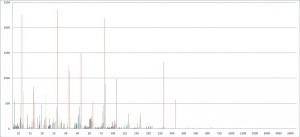
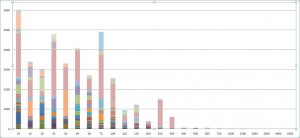
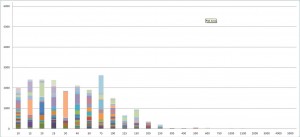
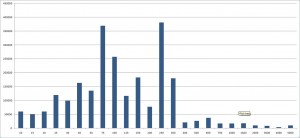
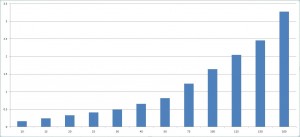
If Scurvy Dogs was omitted because of why I think it was omitted, I think it’s the right call.
Gary, I don’t want to assume, but I think it was filtered out because it’s a board game by two webcomic guys, but not actually from the webcomics they create. Where as Monster Alphabet was directly from Hello with Cheese.
Either that, or mustache envy.
By Darren J. Gendron on 06.11.12 4:07 pm
Definitely interesting stuff. I still think that we don’t really have enough data for any firm conclusions, especially since the individual rewards themselves, and how desirable they are, will make a huge difference – and is also very hard to measure. (Along with measuring the costs of those rewards as well.)
I don’t think one should ignore the lower tiers (since the <$10 range falls in 'impulse spend' for many web denizens), but it is a good point to not over-invest resources into those categories. I suspect a lot of those folks are those who aren't even looking for anything substantial out of the rewards, but simply the nice feeling of contributing a few dollars to a project they support.
The $25 to $75 range, meanwhile, is likely to be where you are seeing the folks who are actually looking to get something substantial for their investment – typically whatever book/game/etc that you are actually producing.
By Myth on 06.11.12 4:17 pm
Fascinating. People can fool themselves on what they HOPE their kickstarter will be, but numbers don’t lie.
By Michael Corley on 06.11.12 6:41 pm
Pretty much right on both counts.
By Gary Tyrrell on 06.11.12 9:57 pm
I wonder about the indirect effects of the lower tiers attracting
higher tiered backers — either through word of mouth (e.g.,
someone pledges at a low tier and then encourages friends / the
internet to pledge so that the project will get funded) or simple
body count (e.g., if high-tier backers are more likely to back a
project that already has a high backer number). It might be
interesting to do a daily sampling of a bunch of projects and
look at the cross-correlation of the time series for the
different tiers.
By Mark V on 06.12.12 1:39 am
[…] has been producing a podcast series of discussions regarding games vis-à-vis Kickstarter. Last week’s number-bothering caught his attention, and we had a nice discussion on Kickstarter, how it applies […]
By Fleen: Home Of The Webcomics Action News Team! » Podcasts And Injunctive Relief And Douchebaggery, Oh My on 06.18.12 3:27 pm
[…] did a recent post where he gathered up a bunch of data for webcomic-related Kickstart projects and tried…. Well worth reading — he was also on a podcast recently about Kickstarter where he talked a […]
By Kickstart My Art » ALTERTAINMENT on 06.26.12 11:28 pm
[…] Fleen’s Breaks Down of Kickstarter Original Source: Fleen […]
By The WCBN: Webcomic and Comic News & Discussion for June 24, 2012The Webcast Beacon Network on 06.27.12 3:35 pm
a comment and a question:
comment – isn’t this data, when plotted, a standard bell curve with the peak at $50 and therefore is just classic normal distribution?
query – has anyone considered the ratio of project viewers to project donors? i.e. google calim 3% is their standard ‘sales success ratio’. what is kickstarter’s viewer to donor success ratio?
By steve on 08.21.12 1:19 pm
a question:
query – has anyone considered the ratio of project viewers to project donors? i.e. google calim 3% is their standard ‘sales success ratio’. what is kickstarter’s viewer to donor success ratio?
By steve on 08.21.12 1:21 pm
[…] of Kickstarter), and the webcomics I looked at were a pitifully small population by comparison (39 projects, if I remember my math), and that’s exactly the sort of situation where local contradictions […]
By Fleen: Home Of The Webcomics Action News Team! » I Hope That’s A Typo And Not An Oversight on 07.01.13 9:47 am
[…] the bits in bold, this campaign is completely screwing with my earlier analysis of successful webcomics Kickstarts, which said that the high-dollar values aren’t going to make up a significant number of […]
By Fleen: Home Of The Webcomics Action News Team! » Time! on 07.01.13 9:50 am
The above comments are owned by whoever posted them. The staff of Fleen are not responsible for them in any way.